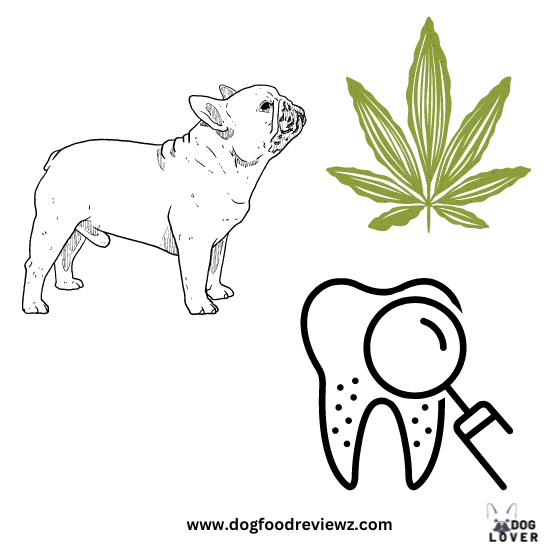Dental problems are a pain in the neck for both pet parents and their furry canine companions. Watching your dog in pain is heartbreaking.
CBD oil is emerging as an effective supplement for canine health problems, including periodontal disease. We dig deeper to enlighten you on this. Read on for additional information.
What is Periodontal Disease?
Plaque bacteria create periodontal disease, inflammation, and infection of the tissues supporting and encircling the teeth. Gingivitis is most frequently seen in dogs and cats. Furthermore, untreated gingivitis and plaque accumulation lead to severe periodontitis.
What causes periodontal disease?
It is important to understand the causes of periodontal disease in dogs. This helps us avoid things within our control. Here are the main causes of canine periodontal disease:
Plaque build-up:
Bacteria and saliva combine to form plaque, which attaches to your pet’s teeth and gums and infects these tissues. This pain is exacerbated when your dog eats anything crunchy, such as apples or carrots.
Plaque is a persistent film of germs, food particles, and saliva continually forming. Toxins produced by bacteria in plaque irritate the gums, making them recede away from the teeth.
As a result, pockets develop between the gum line and the tooth’s surface. Periodontal disease can develop as a result of bacterial infection in these spaces.
Food particles:
Food residue that is not removed from your dog’s teeth will eventually harden into tartar if they are not brushed. If ignored, this may inflame the gums and lead to an infection or other problems.
Bacteria:
Bacteria may accumulate in your dog’s teeth, causing an infection that develops into periodontal disease.
Most of these causes are within your control. Always brush your dog’s teeth to avoid plaque and tartar buildup.
Symptoms of Oral Disease in Dogs
Below are some of the symptoms to look out for:
- Bad breath.
- Bleeding gums.
- Behavioral change.
- Abnormal discharge from the mouth.
- Favoring one side of the mouth when chewing.
- Pawing at the mouth.
The symptoms vary with each stage. Here’s a breakdown of periodontal disease stages in dogs:
Stage 1
Gum disease (gingivitis) causes mild gum swelling and redness. Tartar buildup may be noticeable in some places.
The tooth’s support is still unbroken at this stage.
Stage 2
During this stage, there is moderate to severe loss of ligaments and bones that support your dog’s teeth. There is more inflammation and redness of the gums.
Stage 3
This is where there is approximately 50% tooth loss. There is moderate periodontal disease. A deeper look using an X-ray shows a higher level of tooth loss than in stage 2.
Stage 4
This is an advanced stage with more than 50% tooth loss. The tartar is now fully apparent to the eye. The teeth are at risk because the gums are retreating, and it might be essential to pull a tooth.
How is periodontal illness in dogs treated?
The extent of your dog’s periodontitis will determine the course of treatment. Based on the various stages, there are many treatment plans:
- Stage 1: An expert dental cleaning and fluoride application are recommended to treat gingivitis and stop plaque buildup.
- Stages 2 and 3: To remove plaque and tartar buildup, the teeth will require a deep cleaning or scraping on both sides of the gumline. The vet will polish the teeth to create an even surface that makes it harder for bacteria and plaque to adhere to the tooth. General anesthesia is always required for this surgery.
- Stage 4: When the condition reaches this stage, surgery, which usually entails extractions, will probably be required to treat the afflicted teeth. Extraction occurs if the tooth cannot be saved due to bone loss or infection.
Preventing Periodontal Illness in Dogs
Canine gum problems can be prevented, or at least reduced, with regular oral hygiene. Since it cannot be reversed, it is crucial to remain vigilant and maintain a regular dental regimen.
Preventive care consists of:
- Regular brushing. Use a toothbrush and toothpaste made just for canines. For instructions, ask the vet. You must avoid using human toothpaste. The majority of products include fluoride, which is toxic to dogs.
- Examine the mouth for abnormalities like poor breath, loose teeth, or tartar.
- Providing specialized meals and treats to reduce tartar. The vet will guide you on the best meals that support dental wellness.
- Scheduling annual dental check-ups. This is important, especially in dogs prone to tooth issues. Such breeds include Yorkies, Dachshunds, and Bulldogs.
CBD for Periodontal Disease in Dogs

CBD has been proven effective against the symptoms of periodontal problems in dogs. Research shows that the antibacterial, analgesic (pain relief), and anti-inflammatory characteristics of a full-spectrum CBD product
These features lower the severity of symptoms, making CBD a potential supplement for oral health. Here’s an extensive explanation:
CBD reduces inflammation
Inflammation-causing symptoms, including swelling, aches, and bleeding, result from bacteria in the gums. These are instances where CBD’s inherent anti-inflammatory properties become beneficial.
A study from the Mississippi Medical Center found that CBD can help reduce the chronic inflammation linked to periodontal disease in canines and felines.
This is because CBD can interact with and control the immune system. In particular, CBD improves immune system communication and controls immune cells that trigger the inflammatory cascade.
CBD relieves pain
Pets with oral disease experience daily discomfort due to excessive inflammation and eventual tissue disintegration, aggravating the nerves in the oral cavity.
The gingival pockets that harbor excessive bacteria also contribute to discomfort by releasing enzymes and other degradative substances. All these cause pain, and this is where CBD comes in.
High-quality CBD may successfully treat periodontal disease pain in canines and felines. A study revealed that CBD effectively relieves pain in pets and humans. Another study by Baylor University revealed that CBD significantly reduced pain in animals with joint issues.
CBD is antimicrobial
CBD includes terpenes and cannabinoids that have anti-microbial characteristics. So, CBD effectively heals gum and tooth infections caused by microbes.
Administering CBD for Periodontal Disease in Dogs
In virtually all situations, applying CBD directly to the gums is advisable to encourage immediate absorption. The advice is essentially the same for treating gum disease in cats and dogs, with a few extra suggestions.
Apply it as widely as possible throughout the mouth to ensure every inch of the gums is touched.
If your pet tolerates it, you might consider incorporating CBD into their toothpaste while gently brushing their teeth as you normally would.
Signs of poor oral health in Dogs
Poor oral care exposes your dog to pain and inflammation in the long run. Below are some signs of poor oral health in dogs:
- Bad breath.
- Poor eating habits.
- Brown or yellow teeth.
- Increased drooling.
- Bleeding gums.
- Pawing at the mouth
- Loose or broken teeth.
- Swelling around the mouth.
Possible causes of poor dental health in dogs
Proper dental care from puppyhood on is crucial for strong and healthy teeth. Here are the major contributing factors to poor dental wellness in dogs:
- Certain medical issues include autoimmune disease and diabetes.
- Breed.
- Age.
- Poor oral hygiene.
- Genetics.
- Diet.
How to Keep Your Dog’s Teeth Clean
To maintain your dog’s dental wellness, the best thing to do is to brush its teeth frequently. This can cut down on the frequency of dental cleanings by your veterinarian or even eliminate the need for them. The best way to brush is every day, although brushing a few times a week can also be helpful.
A balanced diet, yearly cleanings, frequent check-ups with the doctor, dental chews, and toys can all help keep your dog’s teeth in good condition. Some dog feeds are specially developed to support tooth health and are frequently vet-prescribed.
How often should you brush your dog’s teeth?
Consistency is crucial when dealing with the oral health of our dogs, just like it is for humans. Although every day is preferred, dog owners should at least brush their dogs’ teeth twice to three times per week. It will be easier on your pup and more probable that they will react well to brushing if you stick to a regimen.
How to brush a dog’s teeth
Brushing your dog’s teeth is not a difficult task. Here are some tips to make the process easier and faster:
- Be comfortable: Get comfortable in a peaceful, distraction-free setting. Your dog may prefer to be held in your lap or covered with a blanket to calm down.
- Start slowly: This prepares your dog. You can start by making your dog sniff or lick the toothpaste. Use your finger initially and gradually introduce a toothbrush. Ensure your finger is well-protected.
- Observe how your dog responds: Be vigilant when brushing your dog’s teeth. If it appears tense, you should stop brushing. Do not force it on your dog.
- Use a soft brush: Look for a brush for dogs or kids. Such brushes have soft bristles and would not hurt your dog.
- Use dog toothpaste: Look for toothpaste made specifically for dogs. Human toothpaste may include harmful substances like xylitol.
- Brush in circular motions: Brush the teeth in small circular motions, paying special attention to the outer surfaces while holding the tip of the brush at an angle of 45 degrees to the gum line.
- Use positive reinforcements: To make your dog enjoy and look forward to tooth brushing, reward it with its favorite toys or treats.
Professional Dental Cleaning
Blood tests are performed before any professional cleaning to see whether your pooch can be sedated. If so, your veterinarian will put them under anesthesia and start a thorough cleaning. This comprises:
- A thorough oral examination and x-rays to look for issues below the gumline
- Complete gum-line cleaning to prevent gum disease
- Professional scaling is used to remove tartar and plaque buildup on the crown.
- Teeth polishing to avoid germs and plaque.
How much does periodontal illness in dogs cost?
Your expenses will range from $250 to $350 for every cleaning and scaling if the vet merely cleans and scales your dog’s teeth and gums. This will cover the cost of the doctor’s appointment and the anesthetic.
You should budget an extra $250 to $300 if the vet requests radiographs to check for potential bone loss. Your expenses will increase by $1,000 to $2,000 if you need teeth or additional X-rays after extraction. You should anticipate costs between $2,000 and $3,000 if your pooch needs complete scaling, cleaning, X-rays, and extractions.
What can happen if you don’t treat gum disease in dogs?
Periodontal illness can seriously affect a dog’s entire body and mouth if left untreated. Eye problems, a higher chance of jaw fractures, organ damage, oral cancer, tooth abscess, and fistula are a few of these health problems.
Is periodontal disease reversible in dogs?
Gingivitis, the earliest stage of gum disease, is the only phase that may be reversed. Gingivitis causes inflammation; it has little impact on the teeth’s bone framework.
Can CBD oil help dogs with periodontal disease?
Yes. CBD oil can help dogs with periodontal disease. Administering CBD reduces the severity of symptoms like pain and inflammation. This is due to its analgesic and anti-inflammatory properties.
How can I reverse my dog’s periodontal disease naturally?
Good nutrition, daily probiotics, bone broth, ozonated water, aloe vera, ozonated oils, homeopathic remedies, and daily oral care are some tips to naturally reverse periodontal disease in dogs.
How do I apply CBD oil to my dog’s gums?
For snappy dogs, drop the oil around or beneath the tongue after gently massaging it onto the sides of their mouth. This will enable immediate bloodstream absorption of the CBD.
What can I give my dog for periodontal disease?
Periodontal disease is an infection, and giving your dog antibiotics helps. CBD oil and its products are also useful as they have anti-inflammatory and pain-reducing properties. Always consult the vet before introducing any medication.
Read more: 10 Best Dog Foods For Dental Health.
How can I treat my dog’s periodontitis at home?
Aloe vera gel has excellent calming effects. Purchase an all-natural, additive-free brand. Alternatively, you may have an aloe vera plant inside your home and cut off a leaf to utilize the gel.
What is the best natural antibiotic for periodontal disease?
Saltwater is one of the easiest and most widely available hacks since it eliminates the pain at its source and works as an antibiotic against gum infections.
What antibiotic kills periodontal disease?
Tetracycline antibiotics are the main medications used to treat periodontitis. These antibiotics include doxycycline, tetracycline hydrochloride, and minocycline. They are antimicrobial, soothe inflammation, and inhibit collagenase.
Can antibiotics treat periodontitis in dogs?
Yes. Antibiotics are effective in the treatment of periodontal disease in dogs. Any infections may be treated with antibiotics like clindamycin, Clavamox for dogs, or Metronidazole for cats and dogs.
How long can a dog live with periodontal disease?
Although periodontal disease alone may not be fatal, it can cause discomfort and infection. There is no defined time frame for survival, but the more severe it becomes, the more likely it is to expose your dog to chronic infections.
Final Thoughts
Periodontal disease causes lots of pain in dogs. This breaks every pet parent’s heart. Additionally, this problem leads to inflammation, which exposes your dog to other infections if not treated early.
The disease involves four stages; the first is the only reversible phase. This makes it important to diagnose and treat it before it becomes chronic.
Overall, CBD may prove immensely beneficial for treating periodontal illness in cats and dogs and promoting canine oral wellness as a supplement to routine veterinary care. Always consult an experienced vet before introducing CBD for periodontitis in dogs.


